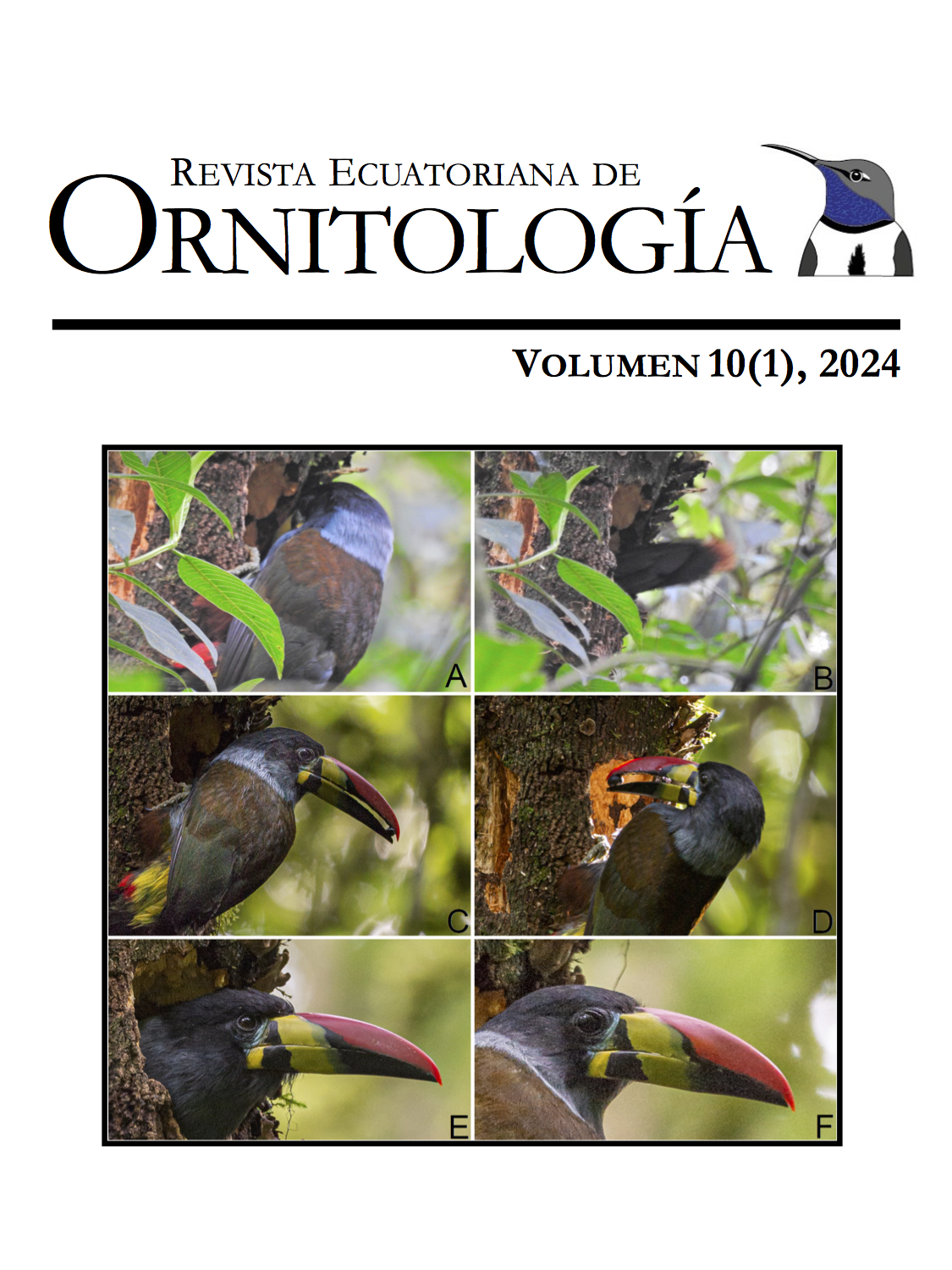PRIMEROS REGISTROS DE CLARINERO NEGRO Quiscalus lugubris (ICTERIDAE) EN ECUADOR
DOI:
https://doi.org/10.18272/reo.v10i1.3086Palabras clave:
dispersión, colonización, comensal humana, Amazonía, deforestaciónResumen
El Clarinego Negro Quiscalus lugubris se está dispersando rápidamente por la Amazonía norte del Ecuador. En esta nota presento los primeros reportes en las provincias de Sucumbíos y Orellana, entre octubre y diciembre de 2022.
Descargas
Citas
Aguilar, J. M. & Freile, J. F. & Tinoco, B. A. (2016). Rapid colonization of Ecuador by the Tropical Mockingbird (Mimus gilvus). Ornitologia Neotropical, 27, 155–162. DOI: https://doi.org/10.58843/ornneo.v27i0.51
Didham, R., Tylianakis, J., Gemmell, N., Rand, T., & Ewers, E. (2007). Interactive effects of habitat modification and species invasion on native species decline. Trends in Ecology and Evolution, 22, 489–496. DOI: https://doi.org/10.1016/j.tree.2007.07.001
eBird. (2023). eBird: an online database of bird distribution and abundance. Ithaca, NY: Cornell Lab of Ornithology. URL: https://ebird.org
Fraga, R. (2020). Carib Grackle (Quiscalus lugubris) version 1.0. En J. del Hoyo, A. Elliott, J. Sargatal, D. A. Christie & E. de Juana (Eds), Birds of the World. Ithaca, NY: Cornell Lab of Ornithology. DOI: https://doi.org/10.2173/bow.cargra1.01
Hualinga, P. & Aguilar, M. (2022, Octubre 3). eBird checklist: https://ebird.org/checklist/S120306593. eBird: an online database of bird distribution and abundance. Ithaca, NY: Cornell Lab of Ornithology. URL: https://ebird.org
Nilsson, J., Freile, J. F., Ahlman, R., Brinkhuizen, D. M., Greenfield, P. J., & Solano-Ugalde, A. (2014). Rare birds in Ecuador: second annual report of the Committee for Ecuadorian Records in Ornithology (CERO). Revista Avances en Ciencias e Ingenierías, 6(2), B38–B50. DOI: https://doi.org/10.18272/aci.v6i2.178
Restall, R., Rodner, C. & Lentino, M. (2006). Birds of northern South America: an identification guide. volume 1. Species accounts. Londres, Reino Unico: Christopher Helm.
Salaman, P., Stiles, F. G., Bohórquez, C. I., Álvarez, M., Donegan, T. & Cuervo, A. M. (2002) New and noteworthy bird records from the Andean East slope of Colombia. Caldasia, 24, 157–189. URL: https://revistas.unal.edu.co/index.php/cal/article/view/39439/41330
Strewe, R., León, C. V., Lobatón, G., Morales, A., & Ayerbe, F. (2006). Ampliación del rango de distribución del chango llanero Quiscalus lugubris (Icteridae) en Colombia. Revista Intrópica, 3, 109–112. URL: https://revistas.unimagdalena.edu.co/index.php/intropica/issue/view/26
Young, K. R. (2009). Andean land use and biodiversity: humanized landscapes in a time of change. Annals of the Missouri Botanical Garden, 96, 492–507. DOI: https://doi.org/10.3417/2008035
Descargas
Publicado
Cómo citar
Número
Sección
Licencia
Derechos de autor 2024 Gabriel Enrique Maldonado Casanova

Esta obra está bajo una licencia internacional Creative Commons Atribución-NoComercial 4.0.
Los autores que publiquen en la Revista Ecuatoriana de Ornitología aceptan los siguientes términos:
- Los autores/as conservarán sus derechos de autor y garantizarán a la revista el derecho de primera publicación de su obra, el cuál estará simultáneamente sujeto a la Licencia de Reconocimiento No Comercial de Creative Commons.
- Los autores/as podrán adoptar otros acuerdos de licencia no exclusiva de distribución de la versión de la obra publicada, pudiendo de esa forma publicarla en un volumen monográfico o reproducirla de otras formas, siempre que se indique la publicación inicial en esta revista.
- Se permite y se recomienda a los autores difundir su obra a través de Internet en su repositorio institucional, página web personal, o red social científica (como ResearchGate o Academia.edu).



